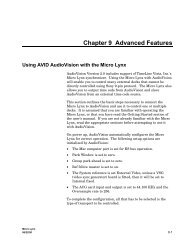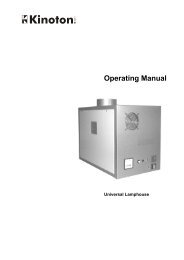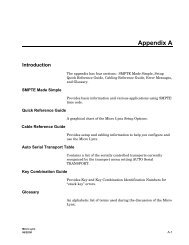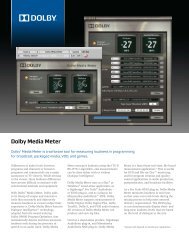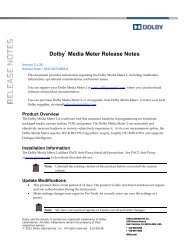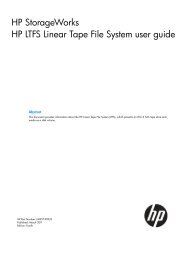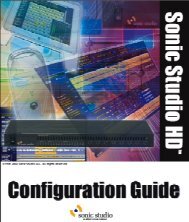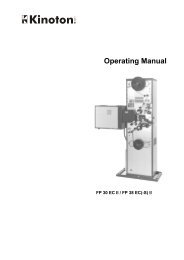Dolby LM100 Broadcast Loudness Meter User's Manual
Dolby LM100 Broadcast Loudness Meter User's Manual
Dolby LM100 Broadcast Loudness Meter User's Manual
You also want an ePaper? Increase the reach of your titles
YUMPU automatically turns print PDFs into web optimized ePapers that Google loves.
The Main Setup Menu<br />
• <strong>Dolby</strong> E Program<br />
• AES3 Channel Select mode<br />
• Analog Input Cal (calibration) settings<br />
On the <strong>LM100</strong>‐NTSC, you can also configure:<br />
• RF Tuning Mode<br />
• RF Channel<br />
• RF Second Language<br />
Input Source<br />
In the Input Source menu, you can select the input to use for a measurement.<br />
A special input source selection (RF/Digital) expects RF input by default, but<br />
automatically switches to digital input if a valid <strong>Dolby</strong> E or <strong>Dolby</strong> Digital signal is present<br />
on the Digital Input connector. This is used when the <strong>LM100</strong>‐NTSC is simultaneously<br />
connected to the digital audio and the channel 3/4 remodulated outputs of a digital cable<br />
set‐top box. Thus, when the set‐top box is tuned to an analog tiered service, the unit<br />
measures the signal directly from the RF tuner; when the set‐top box is tuned to a digitally<br />
tiered service, the unit autodetects the presence of a <strong>Dolby</strong> Digital stream from the S/PDIF<br />
output on the digital set‐top box, and measures it.<br />
Decode Format<br />
Use the Decode Format menu to select the bitstream type you want the <strong>LM100</strong> to decode.<br />
This parameter is normally set to Autodetect. However, you can override this setting and<br />
specify a bitstream type.<br />
<strong>Dolby</strong> E Program<br />
Use the <strong>Dolby</strong> E Program menu to identify which program to measure in a <strong>Dolby</strong> E<br />
stream.<br />
Note:<br />
When the input source is a valid <strong>Dolby</strong> E signal, the selected <strong>Dolby</strong> E program<br />
number must be present in the input stream, or no measurement can be made.<br />
AES3 Channel Select<br />
Use the AES3 Channel Select menu to specify how the unit recognizes a <strong>Dolby</strong> Digital<br />
signal from the digital input.<br />
Selecting Channel 1 or Channel 2 specifies that the <strong>Dolby</strong> Digital input must be<br />
contained within that channel. Selecting Channel 1+2 requires a <strong>Dolby</strong> Digital stream in<br />
both channels. When you select Autodetect, the <strong>LM100</strong> locks onto the first signal it<br />
recognizes. We recommend Autodetect unless there is a signal present in just one<br />
channel.<br />
<strong>Dolby</strong> ® <strong>LM100</strong> <strong>Broadcast</strong> <strong>Loudness</strong> <strong>Meter</strong> User’s <strong>Manual</strong> 29




